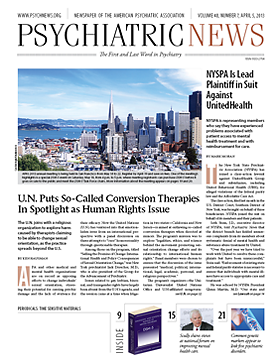The usual model for collaborative mental health care locates specialists at primary care clinics, but including a full-time psychiatrist or psychologist at small practices, especially those in rural areas, can be impractical.
With that in mind, researchers at the University of Arkansas compared depression care using that traditional collaborative approach with one using an off-site multiprofessional team and telepsychiatry.
The “practice-based collaborative care” used the primary care clinicians and on-site nurse care managers at rural health centers to diagnose, treat, and follow patients.
For the “telemedicine-based collaborative care” model, a team of psychiatrists, pharmacists, psychologists, and nurse care managers at the University of Arkansas for Medical Sciences in Little Rock backed up a second group of primary care providers, explained John Fortney, Ph.D., a professor and director of the Division of Health Services Research in the Department of Psychiatry, and colleagues in the February 22 AJP in Advance.
The Arkansas team arranged with five federally qualified health centers in the poor and underserved Mississippi Delta and Ozark Highland areas of Arkansas to screen patients for depression. Local health center staff recruited 364 eligible patients and completed the baseline interviews. Those patients were then randomized to receive either practice-based or telemedicine-based care.
To equalize things a bit, care managers at both locations were required to have no prior specialized mental health experience.
Under the guidance of the specialists back at the university, clinicians in the telemedicine-based group were more likely than their practice-based counterparts to give patients information about depression or its treatment, ask them about symptoms, or ask if they were adhering to treatment.
Together, at 12 months, they achieved greater reductions in depression symptom severity, better response and remission rates, and better quality of life than the local, practice-based staff did.
Patients in the telemedicine model were also seven times more likely to report treatment response and 12 times more likely to achieve remission than were the practice-based patients.
“The fact that the telemedicine group produced better outcomes is big news,” said Peter Yellowlees, M.D., a professor of psychiatry at the University of California, Davis, who was not involved with Fortney’s study. “In the past, studies only demonstrated that telepsychiatry was no worse than in-person care.”
The improved outcomes were achieved without increasing the number of primary care visits, said Fortney and colleagues. They ascribed the difference to “higher fidelity to the care-manager protocol,” despite having the initially similar background as the on-site care manager.
“Over time, the off-site care manager learned more about how to manage patients with depression through her interactions with the other members of the off-site depression care team [such as the pharmacist or psychiatrist], so by the end of the study she was probably more effective than the on-site care managers,” said Fortney in an interview with Psychiatric News. “It might be possible for an on-site care manager to gain such expertise by working with an off-site pharmacist, psychologist, and psychiatrist. That would be an interesting hypothesis to test.”
Telemedicine care managers also seemed to provide more encouragement to patients to engage in self-management activities—such as exercise or social activity. “There’s no doubt that getting patients more involved in self-management produces better results,” Yellowlees told Psychiatric News.
The researchers found no significant differences in antidepressant medication prescriptions or medication adherence between the two groups. Team recommendations about medication changes were usually conveyed to the primary care provider rather than directly to the patient, said Fortney.
However, only 17 percent participated in one telepsychotherapy session, and less than 8 percent completed a full eight-session course.
“I was very surprised by how few patients were willing to use the free psychotherapy that was available to them in their primary care clinic over interactive video,” said Fortney. Patients were referred to a separate visit for telepsychiatric care, but better results might be achieved with a “warm handoff” from the primary care provider to the mental health professional, he said.
One question in an era when health care costs are a key issue is whether a collaborative model using telepsychiatry reduces treatment costs.
“We are still in the middle of our cost-effectiveness analyses and plan to publish those findings separately, so I can’t give you those figures,” Fortney told Psychiatric News. “I do know that the telemedicine-based model was more expensive than the practice-based model, but I don’t know what the incremental cost-effectiveness ratio is yet. Stay tuned.”
“This study validates a novel approach to providing mental health care,” said Yellowlees. “This team approach is the direction in which telepsychiatry is headed. I hope the study will push more groups into working this way.” ■
